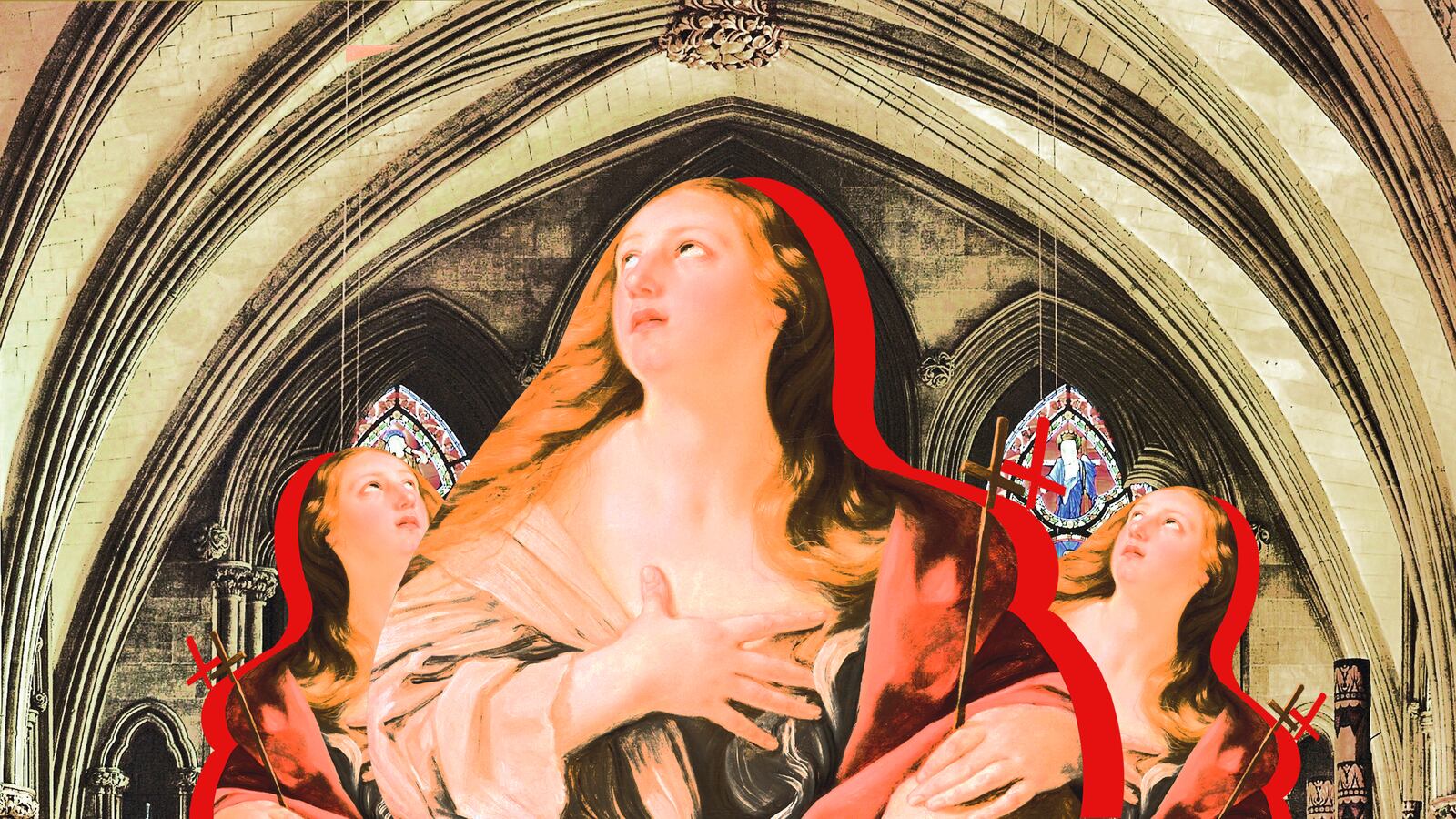At least once a week someone emails me to tell me that Mary Magdalene and Jesus were married. Sometimes, they can trace their own family tree back to history’s most famous non-couple. Best publicized by Dan Brown in The Da Vinci Code the story that Mary M. and Jesus were married and had children is just one of a number of myths about Mary that simply refuses to die.
She wasn’t married to Jesus
If Jesus was married, that’s a fact that would have some serious theological implications. For the conspiracy theorist among us, the possibility that he was married and had children means that there might be a line of special, semi-divine human beings wandering around. For the Catholic Church, the ramifications are even more pronounced. If Jesus was married and had children should not Catholic priests also be allowed to marry and have children? It would set an important precedent for Pope Francis’ recent statements about older married men being able to become priests.
Let’s be very clear, though, none of the texts in the New Testament (which, more importantly, also happen to be the earliest texts written about him) refer to Jesus being married to anyone, much less Mary Magdalene.
There are some second and third century texts like the Gospel of Thomas (Saying 114, in which Jesus also declares he will make Mary male) and the Gospel of Philip (in which Jesus is said to have loved Mary more than his other followers) that suggest a close potentially romantic relationship between the two. What they really show, however, is that second and third century Christians were interested in the figure of Mary and used her as a cipher either for women’s authority in the church in general or, perhaps, as a means of challenging other more powerful Christian competitors. It wasn’t just Mary who received this kind of treatment: There are other early Christian stories in which individual disciples are singled out for special revelations.
But none of these later texts provide evidence for the historical Jesus himself. It may make for an excellent conspiracy theory, but there’s no data that anyone covered up or tried to hide a secret union between Mary and Jesus. And while you could imagine (with Dan Brown) that the boys club that was the medieval Catholic Church might want to eradicate any hint of this kind of scandal, the fisherman disciples that spread the good news in the first decades after Jesus’ death had no such incentive. Why would they have cared about suppressing the fact of Jesus’ supposed marriage when some of them were married themselves? In criminal terms: there’s neither a body, nor a motive.
But she was a disciple, and an important one at that
Just because she wasn’t married to Jesus does not make Mary Magdalene uninteresting. In all four Gospels the first person to witness the resurrection is a woman and Mary Magdalene is in that key group. In the Gospel of John she is alone at the time and it is because of this she is known as the “Apostle to the Apostles,” a truly elevated title and status.
Throughout the Gospels there are references to Mary “following” Jesus and she (like some of the other women) witnesses and, we might infer, supports him during his crucifixion. All of which suggests that Mary was a disciple and part of the core group of Jesus followers. Her presence in Jesus’ inner circle does not mean that she was his wife. In fact, there is something mildly heteronormative and chauvinistic about the assumption that she was.
Mary Magdalene was not a prostitute
If the iconoclastic rumor is that Jesus and Mary were married, the pious myth is that Mary was a prostitute. The identification of Mary Magdalene with the penitent woman who anoints Jesus’ feet with oil and dries them with her hair is cemented in Sunday school tradition, but it isn’t in the Bible.
The misidentification of the two figures was cemented in Christian tradition by Pope Gregory the Great in a homily he delivered in Rome in September 591. Though he was not the first to impugn Mary Magdalene’s reputation, the confusion of several stories from the New Testament has led to lasting impression that Mary of Magdalene was a former prostitute.
We don’t know how old she was
If European artists are to be believed, Mary Magdalene was a beautiful young white woman, with long flowing hair, a sensual attitude, and an odd inability to keep both breasts covered by her dress at the same time. There are a number of things wrong with these portraits (most notably that she is unlikely to have had the kind of alabaster colored skin reminiscent of anaemia), but for now let’s focus on her age. We don’t know anything about Mary’s age, profession, or appearance. The only reason she is depicted in Christian artwork as an attractive young woman is because she has been erroneously associated with sex work. For all we know, Mary was a middle-aged widow.
She was possessed by demons
The one clear biographical detail provided to us (other than her place of origin, Magdala or modern-day Migdal) is that she was once possessed by seven demons (Luke 8:2). This might seem like a straightforward spiritual flaw, but demonic possession in the ancient world was more ambiguous than it is today. Women, by virtue of the heightened porosity of their body, were considered more susceptible to demonic possession than men. For the ancient Greeks, this is one of the things that made women such excellent prophets.
Some modern interpreters want to diagnose Mary with mental illness, often with the commendable goal of providing comfort to those who struggle with mental illness today. But it is worth recognizing that, to an ancient reader, her condition, while negative, was suggestive of heightened supernatural receptivity and sensitivity. After all, in the Gospel of Mark it’s those who were possessed with demons that could recognize who Jesus was.
But we do know she had money
What the Bible does tell us about Mary is that she was comparatively wealthy. Along with Joanna, Suzanna, and other women she traveled with Jesus. And it is these women who are specifically mentioned as having “provided for” the group out of their financial resources. In ancient terms, therefore, Mary Magdalene was one of Jesus’ patrons. Where did her money come from? We aren’t entirely sure, but Magdala was a fishing town so it is possible that she owned some kind of fishing business. The fact that she did support Jesus financially adds further weight to the argument that she wasn’t a prostitute; as classicist Kyle Harper has written, your average prostitute earned about the price of a loaf of bread per customer. A prostitute would not have been in a position to sponsor a messiah.
All of this makes Mary’s fate that much more tragic. Imagine devoting your time and money to supporting a fledgling religious movement only to have history remember you as one of its greatest whores?






